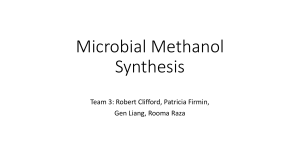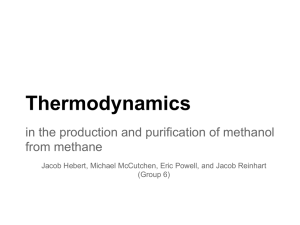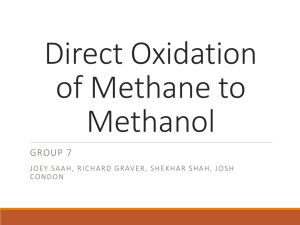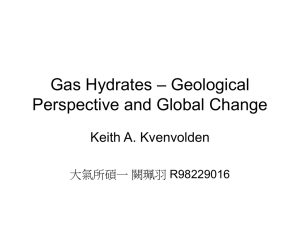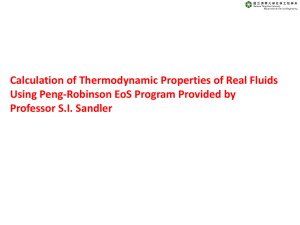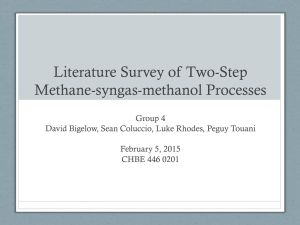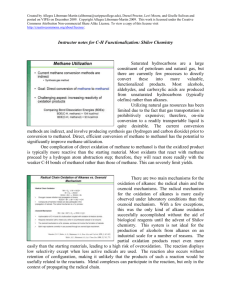reactions kinetics
advertisement
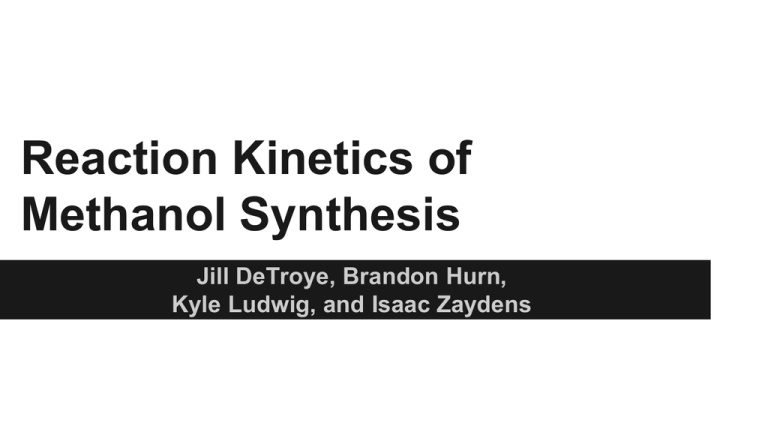
Reaction Kinetics of Methanol Synthesis Jill DeTroye, Brandon Hurn, Kyle Ludwig, and Isaac Zaydens Overview ● Review the Reactions ● Brief Introduction of Catalytic Kinetics ● Discussion of Reaction Kinetics ● Summary and Conclusions ● Questions Reactions ● Our proposed process reactions include: ○ Methane-Steam Reforming (MSR) ○ Water-Gas Shift (WGS) ○ Methane Oxidation (MO) ○ Methanol Synthesis (MS) Reactions Reaction Name Reaction’s Chemical Formula Methane Steam Reforming CH4 + H2O CO + 3H2 Water Gas Shift CO2 + H2O CO + H2 Methane Oxidation Methanol Synthesis #1 (Syngas) Methanol Synthesis #2 (CO2) CH4 + 2O2 CO + 2H2 CO2 + 3H2 CO2 + 2H2O CH3OH CH3OH + H2O Catalytic Reaction Rates ● ● ● ● ● ● Homogeneous - Reactants/Catalysts in same phase Heterogeneous - Reactants/Catalysts in different phase Our purposes: Solid-Phase Catalyst w/ Gas/Vapor Phase Reactants Adsorption Constants (generally K) Rate Constants (generally k) Partial Pressures (pi) Methane Steam Reforming ● Main process for the production ● ● ● of syngas using nickel-alumina catalysts High ratio of steam to methane Moderate temperature Low/moderate pressure Methane Steam Reforming Steam Methane Reforming ● Coefficients change depending on temperature, pressure, and steam-to-methane ratio ● Rates use partial pressures, typical of catalytic kinetics Steam Methane Reforming Steam Methane Reforming Steam Methane Reforming ● Activation Energies, Adsorption Enthalpies, PreExponential Factors Water-Gas Shift ● Moderately exothermic ● K decreases with increasing T ● Kinetically favored at high T, but Thermodynamically ● ● favored at low T Catalyzed by metals and metal-oxides ΔHfo = -41.09 kJ/mol Water-Gas Shift Regenerative Mechanism Associative Mechanism Water-Gas Shift Water-Gas Shift ● Reaction rate based on Langmuir: Methane Oxidation • • • • ΔGo= -801.06 kJ/mol ΔHfo= -802.64 kJ/mol Highly exothermic - Increase in heat shifts reaction to the left Pressure - No change Methane Oxidation Figures adapted from Veldsink et al. Methane Oxidation Catalyst: CuO-γ-Al2O3 ● ● ● k0 = 1.08 (kmol kgcat-1 Pa-1 s-1) EA = 1.25 x 105 (J mol-1) K02 = 1.2 x 10-2 (Pa-1) ● ● KH2O = 1.2 x 10-2 (Pa-1) KCO2 = 5.0 x 10-3 (Pa-1) Figures adapted from Veldsink et al. Methane Oxidation Methane Oxidation Optimal operating conditions: • pCH4≤ 6 kPa • pH2O≤ 8 kPa • pCO2≤ 20 kPa • 0.06 kPa ≤ pCO2 ≤ 22 kPa • 723 K ≤ T ≤ 923 K Methanol Synthesis • • • ΔHfo = -90.55 kJ/mol at 298K ΔGo = -25.34 kJ/mol Exothermic: higher methanol yields are obtained at lower temperatures and higher pressures Methanol Synthesis ● ZnO/Cr2O3 catalyst with copper dispersed on the zincbased catalysts. Methanol Synthesis ● ΔHfo = -49.43 kJ/mol ● ΔGo = 3.30 kJ/mol ● Exothermic: higher methanol yields are obtained at lower temperatures and higher pressures Methanol Synthesis ● ZnO/Cr2O3 catalyst with copper dispersed on the zincbased catalysts Sources ● ● ● ● Hou, Kaihu, and Ronald Hughes. "The Kinetics of Methane Steam Reforming over a Ni/alpha-Al2O Catalyst." Chemical Engineering Journal 82 (2001): 311-28. Web. 10 Feb. 2015. Smith, Byron, RJ, Muruganandam Loganathan, and Murthy S. Shantha. "A Review of the Water Gas Shift Reaction Kinetics." INTERNATIONAL JOURNAL OF CHEMICAL REACTOR ENGINEERING R4 8 (2010): 1-32. Web. 10 Feb. 2015. Veldsink, J.W., G.F. Versteeg, and W.P.M. Van Swaaij. "Intrinsic Kinetics of the Oxidation of Methane Over an Industrial Copper(II) Oxide Catalyst on a Gamma-Alumina Support." The Chemical Engineering Journal 57 (1995): 273-83. Print. "Industrial Methanol from Syngas: Kinetic Study and Process Simulation : International Journal of Chemical Reactor Engineering." Industrial Methanol from Syngas: Kinetic Study and Process Simulation : International Journal of Chemical Reactor Engineering. N.p., 27 Aug. 2013. Web. 12 Feb. 2015.
